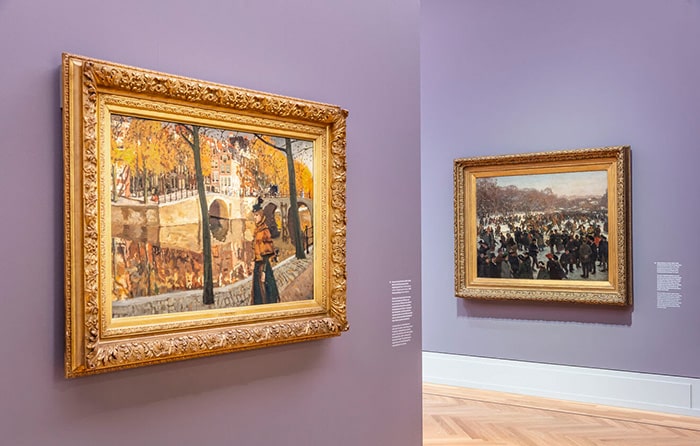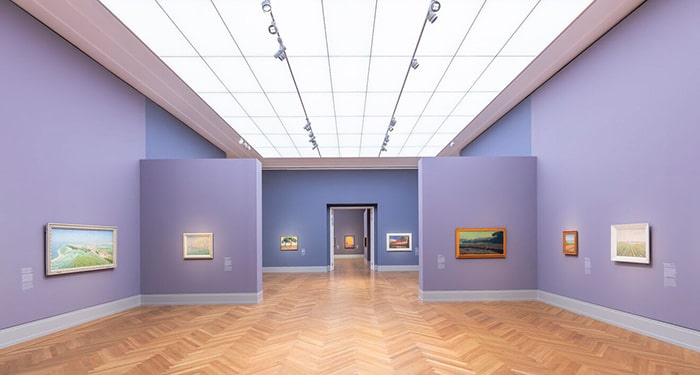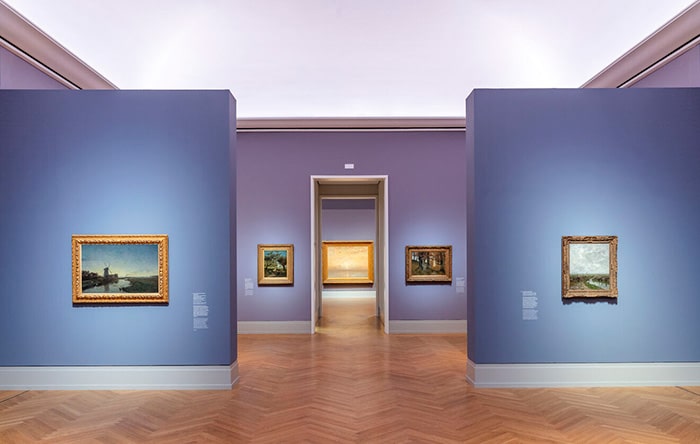From 8 July 2023, the Museum Barberini in Potsdam shows its own Dutch form of Impressionism: Wolken und Licht (Clouds and Light) presents around 100 works by artists ranging from Vincent van Gogh to Piet Mondrian that have hardly been shown in Germany to date. The exhibition Clouds and Light. Impressionism in Holland shows until 22 October 2023 how artists were inspired by French influences to create their very own Dutch form of Impressionism.
Image above: © David von Becker
Landscape painting originated in the Netherlands. The realism of the Old Masters of the 17th century long remained the standard by which it was measured. With the open-air painting developed in France, the Dutch painters of the 19th century received new impulses.
The comprehensive show is the first exhibition devoted to the subject and brings together around 100 works by some 40 artists, including key works by Johan Barthold Jongkind, Vincent van Gogh, Jacoba van Heemskerck and Piet Mondrian that have hardly been shown in Germany to date. The lenders include the Rijksmuseum and the Stedelijk Museum in Amsterdam, the Kunstmuseum Den Haag, the Dordrechts Museum, the Kröller Müller Museum in Otterlo and the Singer Museum in Laren.

Since the 17th century, clouds, waves and beaches in the old-masterly depiction of landscape have been characteristic of Dutch art. It was not until the beginning of the 19th century that landscape art gained relevance throughout Europe with Caspar David Friedrich, William Turner and Pierre-Henri de Valenciennes. When the French Impressionists celebrated the moment in open-air painting as a sign of modernity, this inevitably provoked a reaction from Dutch artists. The exhibition Clouds and Light. Impressionism in Holland is dedicated to this European dialogue. It looks at the development of Dutch art between the 1840s and the 1910s in its dialogue with Impressionism.
The French Impressionists also revered the Dutch landscape painting of the Old Masters. They were less concerned with identifying with a national landscape than with the realism of this painting. Claude Monet spent four months in Holland in 1871. It was here that his model Gustave Courbet had sought distance from the French art world in the 1840s, in order to lend his painting his characteristic realistic, direct approach through the study of clouds and waves. The Hasso Plattner Collection in the Museum Barberini preserves two paintings by Monet from this stay. They show an unusually intense colourfulness and powerful, compact painting style for Monet’s early work.

Dutch artists saw the works of the Barbizon painters during their travels to France and, from the 1880s, in the collection of the painter Hendrik Willem Mesdag in The Hague. Like the French Impressionists in the forest of Fontainebleau, Dutch artists painted the light breaking through the trees in the forest of Oosterbeek from around 1850. The Hague School devoted itself to the polder landscape under high skies and, like Eugène Boudin in France, followed the cloud painting of the Old Masters. Characteristic of the painting of Willem Roelofs, Anton Mauve and Jacob Maris are light grey tones, with which they made rain-laden clouds above the meadow landscape the protagonists of their pictures. The beach is the scene of fishermen going out or landing their catch, whereby, in contrast to marine painting or views of the sea from the Romantic period, subjective observation is already decisive.
The painters of the Hague School were followed in the 1880s by the Amsterdam Impressionists. They discovered the city as a place of modern life with shopping streets, coffee houses and electric light. The beach now became the setting for leisure activities such as walking or donkey riding. Artists like George Hendrik Breitner and Isaac Israels, who knew the works of Claude Monet, Pierre-Auguste Renoir or Gustave Caillebotte from the Paris exhibitions, sought motifs of technical progress and social change in their own surroundings. From 1890 onwards, the next generation of Dutch artists was inspired by French and Belgian Pointillism, which they encountered at exhibitions in Amsterdam and Leiden. The term Luminism was soon coined for the landscapes they created after 1905, which took inspiration from French Fauvism.
Unmixed colours and their expressive heightening in simultaneous contrasts connect the late Vincent van Gogh with the pointillist early work of Piet Mondrian and prove how Impressionism also promoted the avant-garde in Holland. With Impressionism in Russia. Departure to the Avant-Garde, the Museum Barberini presented an exhibition on the European dialogue with French models for the first time in 2021, based on its Impressionist research focus, and presented the arc from the realism of an Ilya Repin to the abstraction of Natalya Goncharova, Mikhail Larionov and Kazimir Malevich.

“After the exhibitions Van Gogh. Still Life and Rembrandt’s Orient, a new chapter of Dutch art takes centre stage at the Museum Barberini. Thanks in part to fantastic lenders such as the Rijksmuseum, the Stedelijk Museum and the Kunstmuseum Den Haag, the exhibition presents a prominent panorama of Dutch cloud painters and light artists,” explains Ortrud Westheider, director of the Museum Barberini.
“Dutch art of the 19th century is hardly ever shown in Germany and, with the exception of the Bayerische Staatsgemäldesammlungen, which purchased works of the Hague School in the 1880s, is hardly represented in local museums. Apart from artists such as Van Gogh and Mondrian, who were present with numerous monographic exhibitions, painters such as Jacoba van Heemskerck, Jan Toorop, Jan Sluijters and many others, who were honoured in the Netherlands with major retrospectives, are virtually unknown in Germany. Due to their proximity to the landscapes of Max Liebermann and the Van Gogh reception of the Brücke artists, they nevertheless appear familiar,” explains Michael Philipp, chief curator at the Museum Barberini and curator of the exhibition.
The exhibition is accompanied by a 312-page catalogue (Prestel, 2023, English/German) with contributions by Sterre Barentsen, Renske Cohen Tervaert, Frouke van Dijke, Marijn Geist, Jacqueline Hartwig, Mayken Jonkman, Jeroen Kapelle, Quirine van der Meer Mohr, Lucien Midavaine, Michael Philipp and Renske Suijver.
An exhibition of the Museum Barberini, Potsdam, in collaboration with the Kunstmuseum Den Haag. Under the patronage of the Ambassador of the Kingdom of the Netherlands in Germany, H. E. Ronald van Roeden.
WHERE?
Museum Barberini
Humboldtstraße 5-6
14467 Potsdam
WHEN?
Saturday, 08. July 2023 – Sunday, 22. October 2023
open 10:00 am- 1:00 pm, daily except Tuesdays (box office closes at 6:15 pm)






